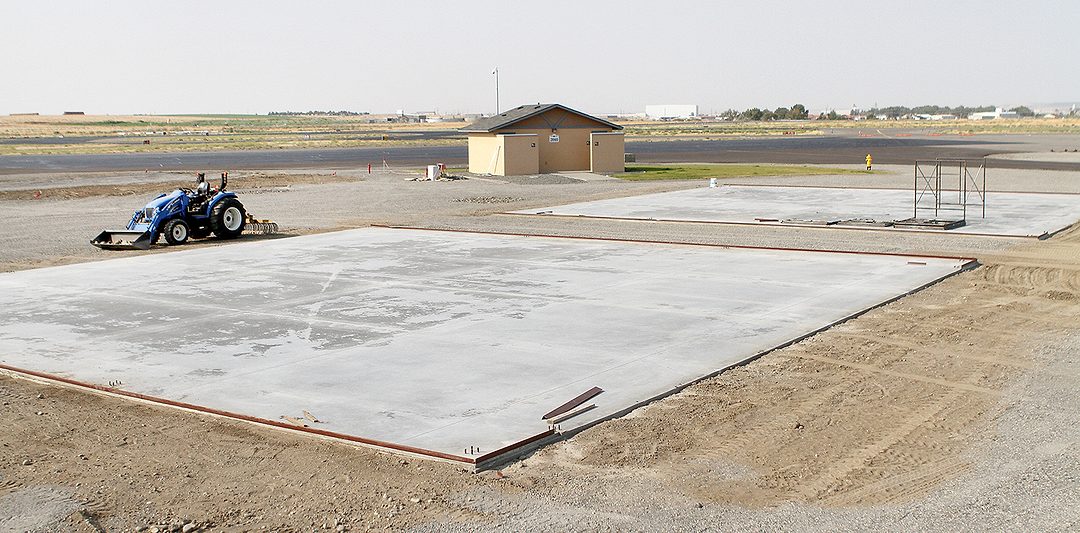
Home » Hundreds of acres available soon in Richland
Hundreds of acres available soon in Richland

May 6, 2018
Work to market 760 acres of federal land transferred to the Port of Benton will kick off in earnest in the coming year.
In 2016, the Department of Energy transferred 760 acres of industrial land from the Hanford site to the Port of Benton and 581 acres to the city of Richland as part of the Mid-Columbia Energy Initiative.
The port, in cooperation with the city, has announced the start of the master planning process for the property, and in 2018, will begin marketing it.
A portion of the acreage nearest to Horn Rapids Road has been conceptually divided into four 150-acre lots — “the largest parcels currently available in the Tri-Cities,” according to a report prepared by BST Associates in January.
The sites strategically leverage existing utility, fiber and road infrastructure.
The area boasts multi-modal transportation with Highway 240 and Interstate 82 close by, barge facilities on the Columbia River as well as two railroads, operated by BNSF Railway and Union Pacific, along with a short-line rail operator.
Biofuels, natural gas refueling stations and offices that support and foster new energy technologies are the prime industrial targets for the sites.
However, the port’s market analysis identified warehousing, distribution, food processing and agriculture as the most likely businesses to capitalize on the available land, noting “rail transportation provides lower-cost transportation for long-distance shipments and for bulk goods.”
Currently, almost all containerized cargo from the Tri-Cities bound for the Puget Sound for international trade are trucked. Empty containers are also trucked back. Most of this cargo consists of agricultural products grown and processed in the Tri-City area, according to the report.
Though there is significant emphasis placed on research and technology jobs in the Tri-Cities, part of the port’s 2017 Comprehensive Plan is “to support existing agribusinesses that are also growing within the county.”
The remaining 900 acres north of the four sites is planned as a “clean energy manufacturing facility,” said Diahann Howard, the port’s director of economic development. “Targeted industries are solar, wind and small modular nuclear reactors.”
The port wants to populate its smaller, 150-acre sites with renewable energy-supportive businesses, a part of its plan to help Benton County diversify the local economy with the gradual replacement of Hanford jobs with similar levels of research and technology jobs.
The port received a $300,000 grant in September 2017 from the U.S. Department of Commerce to support the development of early-stage seed capital funds through the Regional Innovation Strategies program.
The port is the administrator for the Tri-Cities Research District, a state of Washington Innovation Partnership Zone intended to accelerate the development of local startups. The U.S. chamber dollars will support the expansion of education curriculum and business support services to better prepare local companies for seed funding.
This is the first grant of its kind to be awarded to the Tri-Cities. “This is outstanding validation that we are on the right track to grow the Tri-Cities entrepreneurial ecosystem,” Howard said in a news release.
Richland Airport
Following a $1.5 million improvement project that opened new hangars requested by hobbyists and business flyers who use the Richland Airport, the Port of Benton is in the process of completing an extensive pavement rehabilitation project.

Crack sealing, seal coating and new pavement marking work are a part of this project.
About $3.3 million was secured this year in Federal Aviation Administration grants for the work, as well as for pavement maintenance of both runways.
Renovation of the entryway to the Richland Airport off the bypass highway is next on the port’s agenda.
Scott Keller, executive director at the Port of Benton, said the project will include widening of the road and the addition of new signage, including a new archway.
A candidate for the archway’s focal point is the silhouette of the Day’s Pay, a B-17 bomber, whose name stems from the Hanford workers who sacrificed a day’s worth of pay on D-Day to fund the plane during World War II.
A $500,000 helipad is also under consideration in response to high demand.
The Prosser Airport, which the port owns, also will see improvements in the coming fiscal year, including taxi lane improvements and a new electronic gate.
Vintner’s Village, Chukar Cherries
The port expects to be able to award a contract for Prosser’s Vintner’s Village II development by the end of October 2017.
The project got a boost from the Benton County commissioners in September with a $1.2 million infusion from its Rural County Capital Fund. The pot of money is fed by sales tax collected by the county and earmarked for economic development, job creation and tax revenue in the county.

Construction would begin this winter, with the objective of opening in mid- to late summer 2018, before harvest. The county money will pay for architecture, design, surveying, engineering and construction costs.
The $2 million project is intended to attract businesses and mirror the original Vintner’s Village in design and use. The 8,600-square-foot facility will be separated into three bays of about 2,500 square feet, plus additional office space that will be leased to private sector operators to promote the local wine industry.
The pre-built bays in the village will serve as a springboard for small companies to expand their businesses and eventually transition into their own facilities on the remaining 22 acres of the site.
But high demand for construction services has driven cost projections higher than anticipated, often causing delays in building and greater timidity among companies to expand, Keller said.
The port continues to actively market the lots, which are shovel-ready with infrastructure already in place.
“We do things a little more like a business does … we’re very opportunistic … we take action where we see a need and help the people and community,” Howard said.
The port is also in the process of designing a separate 12,000-square-foot expansion for Prosser’s Chukar Cherries.
“They are a great company for Prosser and for the port,” Keller said.
A tenant since 1988, Chukar Cherries specializes in foods and gifts crafted from locally-grown cherries and berries.
The company’s new building will bring its total square footage up to 30,000 square feet.
“It all depends on the bidding climate though,” Keller said. “If it’s too costly, we will have to re-evaluate.”
Recreation areas
This year marks 10 years of the port’s successful Crow Butte Park revitalization project with ongoing improvements to its existing amenities, including expanded dock facilities and electrical upgrades.
The 275-acre park is on an island in the southwest corner of the county, outside Paterson.
Another one of the port’s current objectives is to entice Tri-City residents to spend more time in north Richland by adding more amenities and recreational opportunities there.
As more housing goes up, the port’s vision for a vibrant, united north Richland community comes closer to realization. Keller said collaboration is the key.
In 2011, the sail and conning tower of the Cold War-era USS Triton nuclear submarine found its new home adjacent to the Port of Benton building.
It’s included as part of the National Park Service’s B Reactor tour, and the port is looking to expand the exhibit by building a $1 million visitor center to showcase other sail components currently in storage.
“In the next year, we hope to initiate, start and develop the infrastructure and seek grant opportunities to help fund the project,” Howard said.
Guests will have the opportunity to learn more about this often-overlooked part of military history and explore a facility that provides the feeling of being onboard a submerged submarine.
“It’s an exciting time at the port,” Keller said.
Managing 13 areas throughout Benton County, totaling 2,756 acres worth of $83 million in assets, keeps Port of Benton staff busy.
“It’s never boring around here,” he said.
Construction + Real Estate
KEYWORDS focus real estate construction 2017




